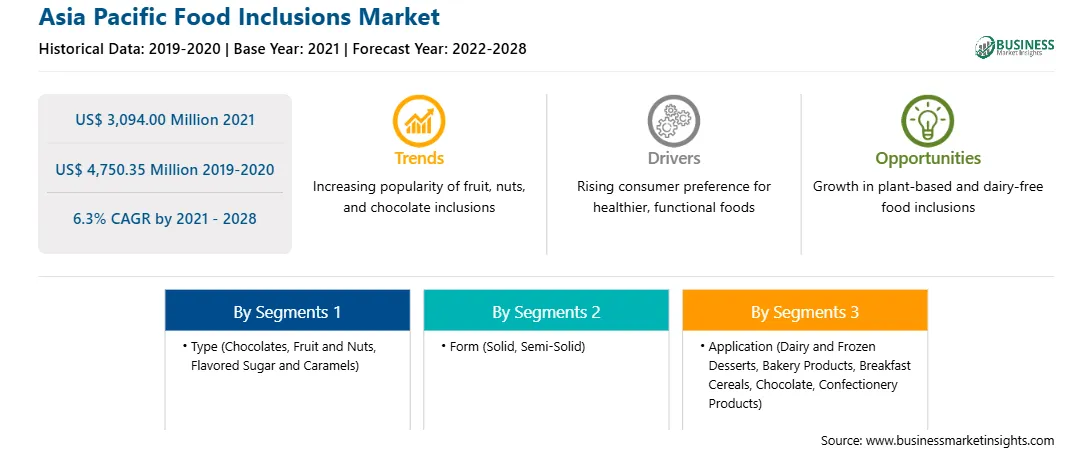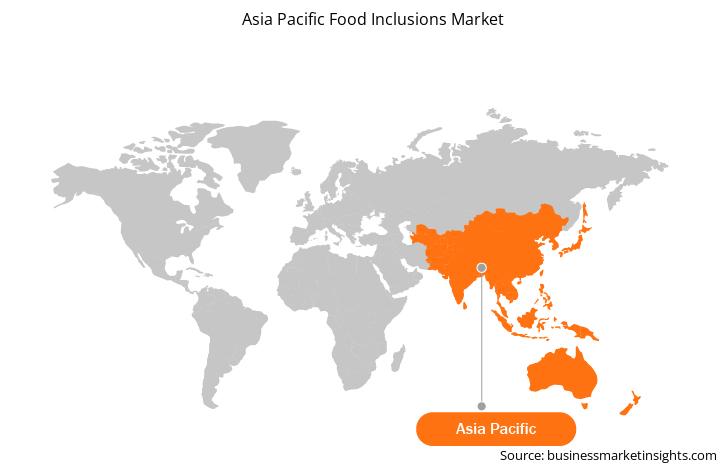The food inclusions market in Asia Pacific is sub segmented into China, Japan, India, Australia, South Korea, and the Rest of Asia Pacific. These economies are experiencing rapid economic growth, surge in the number of manufacturing companies, and considerable growth in the organized retail and service sectors as a result of population growth, favorable government regulations, liberal trade policies, the availability of abundant resources, and cheap labor and manufacturing facilities. The Asia Pacific food inclusions market is attributed to the growing trend of westernization of diet as well as increased consumption of inclusions and their innovative use as per the desired flavor profile and other consumer requirements. In addition, prominent influence of western culture, especially on eating habits, along with rapid urbanization, modern lifestyle, hectic work schedules, and so on, are driving the consumers preference toward convenience food such as frozen food, bakery products, sweet and savory snacks, breakfast cereals, and dairy products. Food inclusions are added to such food products to improve their appeal and taste. They can impart any desired flavor and texture, hence increasing the appeal of food products. The rising disposable income of consumers in this region—owing to rapid economic growth, increased wages, and surge in employments—is one of the key factors bolstering the demand for convenience food, eventually driving the food inclusions market growth..
The COVID-19 is anticipated to cause a significant economic loss in the Asia-Pacific. In the Asia Pacific region India is the worst affected country due to COVID-19 followed by japan, South Korea, and China. The consequence and impact can be even worse and totally depends on the spread of the virus. The governments of various Asia-Pacific countries are taking possible steps to restrict the spread of the virus by announcing lockdown, which in turn has negatively impacted the revenue generated by the food inclusions market. The food inclusions market has had a major impact on its product trends. The pandemic has propelled consumers to opt for healthy food products with various functional properties.

Strategic insights for the Asia Pacific Food Inclusions provides data-driven analysis of the industry landscape, including current trends, key players, and regional nuances. These insights offer actionable recommendations, enabling readers to differentiate themselves from competitors by identifying untapped segments or developing unique value propositions. Leveraging data analytics, these insights help industry players anticipate the market shifts, whether investors, manufacturers, or other stakeholders. A future-oriented perspective is essential, helping stakeholders anticipate market shifts and position themselves for long-term success in this dynamic region. Ultimately, effective strategic insights empower readers to make informed decisions that drive profitability and achieve their business objectives within the market.

| Report Attribute | Details |
|---|---|
| Market size in 2021 | US$ 3,094.00 Million |
| Market Size by 2028 | US$ 4,750.35 Million |
| Global CAGR (2021 - 2028) | 6.3% |
| Historical Data | 2019-2020 |
| Forecast period | 2022-2028 |
| Segments Covered |
By Type
|
| Regions and Countries Covered | Asia-Pacific
|
| Market leaders and key company profiles |
The geographic scope of the Asia Pacific Food Inclusions refers to the specific areas in which a business operates and competes. Understanding local distinctions, such as diverse consumer preferences (e.g., demand for specific plug types or battery backup durations), varying economic conditions, and regulatory environments, is crucial for tailoring strategies to specific markets. Businesses can expand their reach by identifying underserved areas or adapting their offerings to meet local demands. A clear market focus allows for more effective resource allocation, targeted marketing campaigns, and better positioning against local competitors, ultimately driving growth in those targeted areas.

The food inclusions market in Asia Pacific is expected to grow from US$ 3,094.00 million in 2021 to US$ 4,750.35 million by 2028; it is estimated to grow at a CAGR of 6.3% from 2021 to 2028. Food inclusions are ingredients or variegates incorporated in different food products and beverages to impart unique properties such as color, flavor, and texture. Several food inclusions are also known for their nutritional benefits. They have a wide application scope, including baked products, confectioneries, sweet and savory snacks, frozen desserts, beverages, breakfast cereals, and dairy products. The ingredients are available in forms such as freeze-dried, infused, case-frozen, micro-dried, individually quick frozen (IQF), spray-dried, and whole foods, and are selected depending on their application. Consumer buying behavior and consumption pattern, as well as eating experience are highly influenced by the texture and flavor of a food product. Thus, it is necessary to select the most suitable format of a food inclusions for a particular application. For instance, infused blueberries are used to render a complete mouth-feel and chewiness, whereas freeze-dried blueberries are used to achieve crispiness. Furthermore, dehydrated blueberries are used in foodstuffs or beverages requiring standout presence of blueberries. In the bakery segment, food inclusions have been in use for a long period to enhance the sensory properties, texture, aesthetics, and provide indulgence. Further, many of food inclusions are rich in proteins, essential fatty acids, vitamins, and fiber. Tree nuts, dried fruits, spices, herbs, exotics fruits, cocoa nibs, chocolate, etc., are the majorly used inclusions in bakery products. Further, fruits, nuts, and chocolates are the major food inclusions types used in dairy products and frozen desserts such as ice cream, yogurt, and cheese. For instance, in cultured yogurts, sweet fruits are mainly used as an inclusions to balance the tangy flavor of the cultured yogurt. Food inclusions are mainly added as individually quick-frozen ingredients in dairy products and frozen desserts. The frozen desserts and dairy products application of food inclusions is challenging as they highly influence the overall texture, flavor profile, and shelf life of the final product. Further, beverage manufacturers are highly focusing on food inclusions to cater the rising consumer demand for natural beverages. Exotic fruits, vegetables, tree nuts, and chocolate are the majorly consumed inclusions in various beverages. Beverages in which these ingredients are being incorporated include functional water, flavored water, tea, beer, energy drinks, wine, and milk. Such a wide application scope of food inclusions is a major factor driving the market growth.
In terms of type, the chocolate segment accounted for the largest share of the Asia Pacific food inclusions market in 2020. In term of form, the solid segment held a larger market share of the food inclusions market in 2020. Further, the bakery products segment held a larger share of the market based on application in 2020.
A few major primary and secondary sources referred to for preparing this report on the food inclusions market in Asia Pacific are company websites, annual reports, financial reports, national government documents, and statistical database, among others. Major companies listed in the report are ADM; AGRANA Beteiligungs-AG; Puratos; Barry Callebaut; Cargill, Incorporated; Kerry Group; Georgia Nut Company; Taura Natural Ingredients Ltd.; and Sensient Technologies among others.
The Asia Pacific Food Inclusions Market is valued at US$ 3,094.00 Million in 2021, it is projected to reach US$ 4,750.35 Million by 2028.
As per our report Asia Pacific Food Inclusions Market, the market size is valued at US$ 3,094.00 Million in 2021, projecting it to reach US$ 4,750.35 Million by 2028. This translates to a CAGR of approximately 6.3% during the forecast period.
The Asia Pacific Food Inclusions Market report typically cover these key segments-
The historic period, base year, and forecast period can vary slightly depending on the specific market research report. However, for the Asia Pacific Food Inclusions Market report:
The Asia Pacific Food Inclusions Market is populated by several key players, each contributing to its growth and innovation. Some of the major players include:
The Asia Pacific Food Inclusions Market report is valuable for diverse stakeholders, including:
Essentially, anyone involved in or considering involvement in the Asia Pacific Food Inclusions Market value chain can benefit from the information contained in a comprehensive market report.